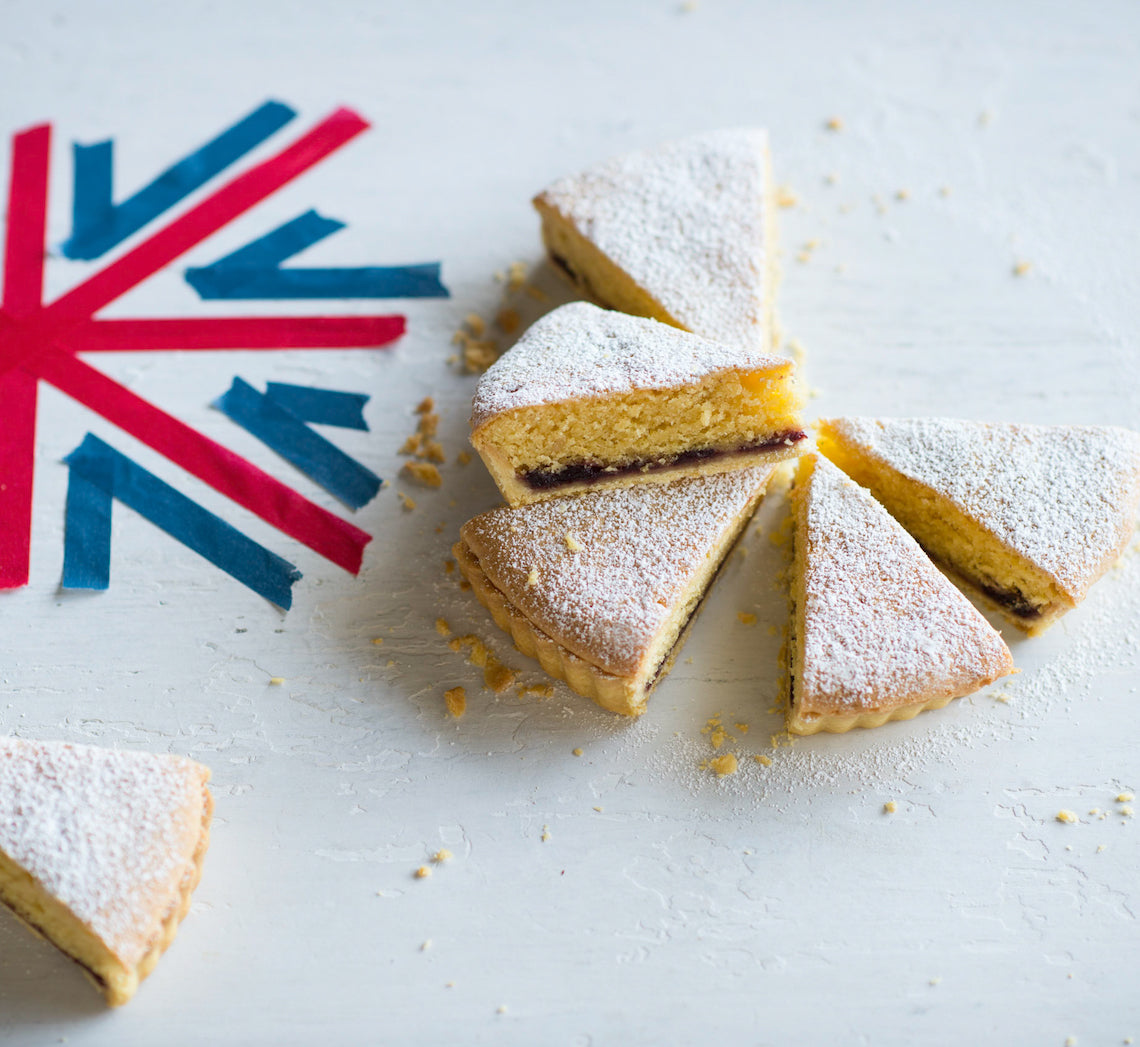- home
- BAKERECIPES
BakeRecipes
Bringing real baking into your home with deliciously simple recipes.

Prep 25minBake 30-35minMakes 8-10 serves
This traditional English pudding is quintessential nursery food – nurturing, soul-warming and economical. Feel free to replace the mixed berry jam with raspberry, plum or strawberry to ensure the sweet but subtle middle layer suits your tastes.
Ingredients
500ml (2 cups/17fl oz) milk
55g (¼ cup/2oz) caster sugar
30g (1 oz) salted butter, diced
Finely grated zest of 1 lemon
5 egg yolks (from 60g/2oz eggs), at room temperature
2½ teaspoons natural vanilla essence or extract
150g (2½ cups, lightly packed/5¼oz) fresh white breadcrumbs
85g (¼ cup/3oz) mixed berry jam (see Baker’s Tips)
1 tablespoon icing sugar, to dust
Meringue Topping
3 egg whites (form 60g/2oz eggs)
Large pinch of salt
110g (½ cup/4oz) caster sugar
1 teaspoon natural vanilla extract or essence
Method
- Put the milk, sugar, butter and lemon zest in a medium saucepan and stir over medium heat until the sugar dissolves and the butter melts. Use a balloon whisk to whisk the egg yolks in a medium heatproof bowl until smooth. Gradually add the warm milk mixture, whisking constantly until well combined. Stir in the vanilla and breadcrumbs.
- Pour the custard mixture into a shallow 1-litre (4-cup/1.75pt) ovenproof dish. Set aside for 15 minutes for the bread to soak up some of the custard.
- Preheat oven to 170ºC/340°F (150ºC/300°F fan-forced).
- Place the ovenproof dish into a roasting pan or larger ovenproof dish. Add enough boiling water to the roasting pan or larger ovenproof dish to reach halfway up the sides of the dish with the custard mixture to create a water bath or bain-marie.
- Bake in preheated oven for 20-25 minutes or until the custard has almost set but still wobbles slightly when touched on the top. Remove from the oven and remove the custard dish to a wire rack. Set aside for 20 minutes or until cooled slightly (stop here if pre-preparing your pudding, see Baker's Tips).
Increase the oven temperature to 190ºC/375°F (170ºC/340°F fan-forced).
- To make the Meringue Topping, use an electric mixer with a whisk attachment to whisk the egg whites and salt on medium-high speed until soft peaks form. With the motor running, gradually add the sugar, a spoonful at a time, and whisk until the sugar has dissolved completely and the mixture is thick and glossy. Whisk in the vanilla.
- Carefully spread the jam over the top of the custard (see Baker's Tips). Spread the Meringue Topping over the jam to cover, swirling as desired.
- Bake in preheated oven for 10 minutes or until the meringue is lightly golden (see Baker’s Tips). Serve immediately.
Baker's Tips
- You can cover the bottom of the roasting pan or larger ovenproof dish with a folded tea towel to stop the dish with the custard sliding around when transferring it to and from the oven.
- You can make this pudding up to the end of step 4 (note in method) up to 2 days before serving. Stand the puddings at room temperature for 30 minutes before continuing with the recipe.
- If your jam is a little thick you can warm it in a small saucepan over a low heat, stirring often, until runny, to make it easier to spread.
- You can caramelise the meringue topping with a blowtorch instead of baking it a second time for a more ‘dramatic’ effect if you wish.
This recipe is from Anneka's SBS Food online column, Bakeproof: Best of British Baking.
CLICK HERE for more Bakeproof recipes.
Photography by Alan Benson.

Prep 30minBake 1hr20minMakes about 8-10 serves
Bakewell tart is simply a buttery almond cake in a tart case with a welcome layer of jam in the middle. On first consideration you may not think this combination would work, but take my word for it, it does!
Ingredients
1 quantity sweet shortcrust pastry115g (⅓ cup) raspberry or cherry jam
125g unsalted butter, at room temperature
110g (½ cup) caster sugar
3 drops of almond essence or finely grated zest of 1 lemon
3 eggs
100g (1 cup) almond meal
35g (¼ cup) self-raising flour
icing sugar, to dust
Method
- Preheat oven to 200ºC (180ºC fan-forced).
- Use a lightly floured rolling pin to roll out the pastry on a lightly floured bench top to a round about 3mm thick. Carefully drape the pastry loosely around the rolling pin. Place it over an ungreased round 23cm (base measurement) tart tin with a removable base and then unroll the pastry being careful not to stretch it. Gently lift the edge of the pastry and ease it into the tart tin to line the base and sides and settle it into the corners. Use your fingertips to press it gently into the corners without stretching it. Then, working around the tin, press the pastry into the side using your thumb or finger. Roll the rolling pin over the top of the tart tin to trim any overhanging pastry.
- Place the tart tin on an oven tray. Prick the pastry base with a fork about 12 times. Line the pastry case with baking paper or foil and fill with pastry weights, dried beans or raw rice, making sure they press into the corners and they fill the case. Bake in preheated oven for 15 minutes.
- Remove the pastry case from oven and use the paper or foil to lift the weights out of the case. Return to the oven and bake for a further 15-20 minutes or until cooked through and lightly golden. Remove from the oven.
- Spread the jam evenly over the base of the tart case and set aside. Reduce the oven temperature to 160ºC (140ºC fan-forced).
- Use an electric mixer to beat the butter, sugar and almond essence or lemon zest until pale and creamy. Add the eggs one at a time, beating well after each addition. Combine the almond meal and flour, add to the butter mixture and beat on lowest possible speed until just combined. Spread the mixture evenly over the jam in the tart case.
- Bake in preheated oven for 40-45 minutes or until golden brown and a skewer inserted into the centre comes out clean. Cool in the tin for 10 minutes before removing, dusting with icing sugar and serving warm. Alternatively cool in the tin and serve at room temperature.
Baker's Tips
- This tart will keep in an airtight container at room temperature for up to 2 days.
This recipe is from Anneka's SBS Food online column, Bakeproof: Best of British Baking.
CLICK HERE for more Bakeproof recipes.
Photography by Alan Benson.

Prep 20minBake 40-45minMakes 16 serves/wedges
Mary Queen of Scots' fondness for shortbread is said to be the reason for its increased popularity in the 1500s. Nowadays it is loved so much there is even a National Shortbread Day on the 6th January each year! The key to good shortbread is slow baking until it is pale golden and cooked through – if over baked, or baked too quickly, it will become slightly bitter in taste due to the ‘burnt’ butter.
Ingredients
250g (9oz) salted butter, cubed and softened slightly
110g (½ cup/4oz) white granulated sugar, plus 1 tablespoon extra to sprinkle
300g (2 cups/10½oz) plain flour
55g (⅓ cup/2oz) rice flour
Method
- Preheat oven to 160ºC/315°F (140ºC/285°F fan-forced). Use a 20cm/4cm cake tin to draw a circle on two separate pieces of non-stick baking paper, turn over and set aside.
- Use an electric mixer to beat the butter and sugar until starting to become pale and creamy, but not too aerated (do not over mix).
- Sift together the plain flour and rice flour, add to the butter mixture and use a wooden spoon and then your hands to mix until evenly combined and a soft dough forms. Divide the dough in half and shape both portions into discs.
- Place each disc in the centre of the marked circles on the baking paper and use a lightly floured rolling pin to roll each out to fill the circles. Use your fingertips to neaten the edges and then pinch the edges to create a decorative edge. Use the baking paper to lift the shortbread rounds onto two oven trays. Sprinkle with the extra sugar, dividing evenly between the rounds. Use a large sharp knife to mark each round into 8 wedges and then use a fork to pick each wedge three times.
- Bake in preheated oven for 40-45 minutes, swapping the trays around half way through baking, or until pale golden and cooked through. Cool on the trays. Cut into wedges to serve.
Baker's Tip
- This shortbread will keep in an airtight container at room temperature for up to 1 week.
Variations
Shortbread Fingers: Use a lightly floured rolling pin to roll a dough portion until about 8mm/3/8in thick. Sprinkle with the extra sugar. Use a large sharp knife to cut into 4cm x 7cm (1½in x 2¾in) fingers, re-rolling and cutting any offcuts. Place on the oven trays about 2cm/¾in apart and use a fork to prick each finger four times. Repeat with the reaming dough portion. Bake in preheated oven for 25-30 minutes, swapping the trays around half way through baking, or until pale golden and cooked through.
Brown Sugar Shortbread: Replace the white granulated sugar with brown sugar or dark brown sugar.
This recipe is from Anneka's SBS Food online column, Bakeproof: Best of British Baking.
CLICK HERE for more Bakeproof recipes.
Photography by Alan Benson.






